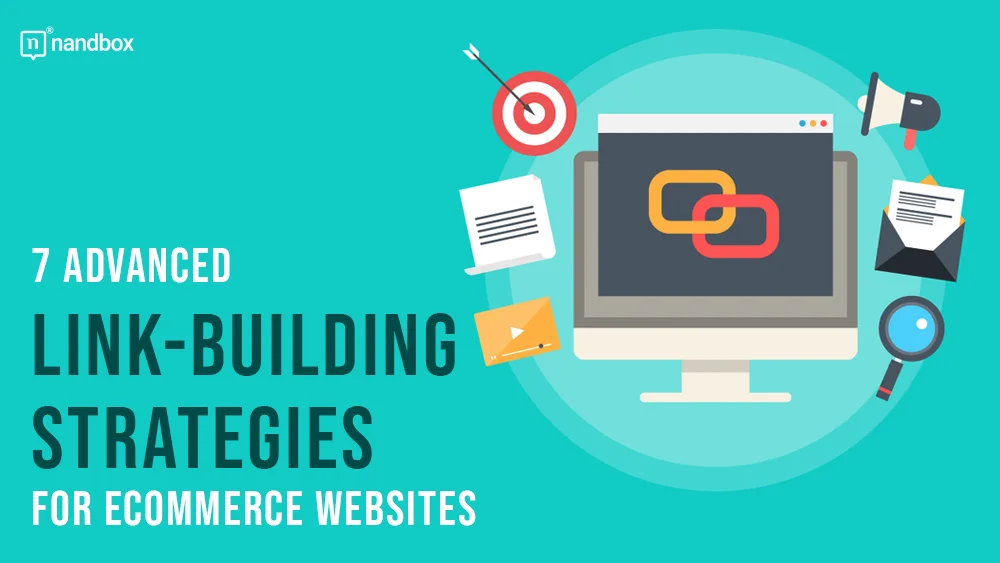Link building involves creating backlinks to your website. Backlinks refer to links from other websites that point to your own. Typically, backlinks are essential to improving your website’s visibility and authority. In turn, this can lead to increased traffic, higher search engine rankings, and ultimately, increased sales for your eCommerce site. In this article, we’ll explore seven advanced link-building strategies you can adopt for your eCommerce website. Let’s dive in!
What Is eCommerce Link-Building?

Ecommerce link building strategies are the process of acquiring links from other websites to your ecommerce website. It involves creating high-quality content that other websites would want to link to. Often, this will warrant building relationships with other website owners and utilizing other tactics like guest posting, social sharing, and content collaborations to attract links to your website. Link-building strategies are incredibly helpful for eCommerce brands. This is because search engines consider backlinks to be a critical factor in determining a website’s authority and relevance. Understanding the link-building benefits can help businesses improve their search engine rankings and drive more organic traffic to their sites. So, by acquiring links from other high-authority websites, you can enhance your eCommerce SEO efforts and attract potential customers to your own eCommerce website.
7 eCommerce Link-Building Strategies to Use
Just like link-building for SaaS brands, if you own or manage an eCommerce store, it’s important to apply the right backlinking techniques. The wrong techniques can have detrimental effects on your online visibility and reputation. So, let’s explore seven advanced techniques that you can use to build high-quality backlinks to your eCommerce store:
1. Find Unlinked Brand/Product Mentions
One effective way to build links to your eCommerce website is to find unlinked brand or product mentions. These are instances where your brand or product is mentioned on another website, but there is no hyperlink to your eCommerce website. You can use tools like Google Alerts to monitor mentions of your brand or products online. Google Alerts is a free service that sends you an email notification whenever new content that matches your search terms is published.
So, you can add your brand name as seen in the example below: You can also add other brand-related keywords you want to receive notifications for. Once you find unlinked mentions, reach out to the website owner and ask them to add a link to your website. Thankfully, you can use email finder tools to find the email address of any site owner you want to reach. You may also send messages on their social handles if possible.
When reaching out to website owners, emphasize the value that a backlink to your website can bring to them. This may include the benefit of providing their readers with additional resources, improving their website’s authority and credibility, or simply fostering a mutually beneficial relationship. Additionally, it’s helpful to provide a brief description of your eCommerce website and the products or services you offer. This gives the website owner a clear understanding of who they are linking to. By doing so, you can increase the likelihood that the target website will be interested in providing you with a backlink.
2. Create and Publish Resource and Statistics Pages
Creating useful resources will encourage other site owners to link to you. When other site owners link to your content, it helps to improve your website’s search engine ranking and it can also help to drive traffic to your website. It also positions you as an expert on a specific topic.
Some specific types of link-worthy resources you can publish on your eCommerce website include:
- Industry statistics.
- Market research
- Case studies.
- How-to guides.
When creating your statistics and resource pages, focus on topics that are relevant and interesting to your target audience. A good example is Filter King’s blog post about the cleanest states to visit. When publishing any resource or statistics on your website, ensure that the data you provide is accurate. This means that you must give yourself diligent research and credible information sources. You also want the content to be well-written and informative. Finally, take the liberty to promote your resources on social media and other online channels so other site owners can discover them.
3. Identify Opportunities for Guest Post Updates
Guest posting is popular in link-building strategies that involve writing content for other websites in your niche. This is one of the most effective SaaS link building strategies, and it can work just as brilliantly for eCommerce brands. However, you can take guest posting to the next level by identifying opportunities for guest post updates. For this, you may offer to update previously published blog content with fresh and relevant information, including a link to your eCommerce website. Following influencers and industry publications on social platforms like Facebook, Twitter, or LinkedIn is one way you can easily spot guest posting opportunities. You can also use Google Alerts to set up keywords based on topics you want to write about.
In some cases, you may get a backlink in an author bio like the example below which will be included at the bottom of your published content. Typically, this depends on the site you’re writing for. However, in most cases, you may be fortunate enough to have a backlink within the article you submit— so, be sure to put your best foot forward by linking to informative and valuable content. Optimize content that you submit by making sure you use the right heading structures, keywords, and meta description. Also, include internal links pointing to content within the guest website. When it comes to guest posting, it’s important to pay attention to the guidelines that some of these target websites may have–for instance, word count limits or preferred topics. This will increase your chances of having your guest post accepted and published.
Furthermore, focus on guest posting opportunities that align with your target audience. You don’t want to have guest posts on random sites that don’t speak to your potential customer, as this won’t do much good for your eCommerce website.
4. Utilize the Product Feedback Tactic
The product feedback tactic involves reaching out to bloggers and influencers in your niche and offering them a free product in exchange for an honest review. When it comes to utilizing the product feedback tactic, here are some important things to note:
- Take some time to identify influencers and reviewers you want to work with. You can use listening tools like Buffer to see what kind of content the influencer’s audience is interested in and determine if it aligns with your brand.
- Connect with individuals who have a track record of publishing honest and unbiased reviews.
- Send a personalized outreach message that explains what your product is and why it would be a good fit for the reviewer’s audience.
Personalizing your message will show potential reviewers that you are genuinely interested in working with them. Also, when sending your outreach messages, keep your tone friendly and professional. Avoid being pushy or creating an unnecessary sense of urgency, as this can turn off reviewers.
5. Highlight the Unique Features of Your Product
In addition to offering a free product, offer something else of value to the bloggers and influencers you choose to work with. This could be a discount code for their readers, early access to new products, or even a shoutout on your social media channels. Don’t forget to spark their interest in your product by highlighting its unique features and benefits. Finally, it’s important to follow up with reviewers after they receive your product to ensure that they are happy with it and to remind them to publish a review. Make sure to express gratitude for their time and effort and provide any additional information or support they may need.
So, to get the most out of these reviews, share them on your social channels as well. Besides, this type of content can also easily help you get Facebook comments, Instagram followers and even shares. After all, it’s content created by individuals who hold sway over their audience and yield a huge influence in their niche.
6. Take Advantage of the Haro Technique
HARO (Help a Reporter Out) is a platform that allows you to provide information to journalists on specific topics. It’s a great way to get your business in front of a large audience. The HARO technique will work for every business type, whether it’s to boost link-building for a law firm, marketing agency, or eCommerce store like yours. Your experience as an eCommerce store owner could be a useful resource for the reporter’s publication. So, you can maximize HARO by responding to queries from journalists. If you provide valuable insight, then there’s a good chance that you’ll be quoted in the published articles or blog posts. This can also help to enhance your credibility and establish you as an expert in your field. Of course, imagine the level of awareness your brand will also get if featured in a high-quality publication.
To use HARO, you simply need to sign up as a source. Then, indicate your topics of interest and expertise when setting up your profile. Once you’re signed up, you’ll receive three emails per day with a list of queries from journalists. As seen in the example, the query will include the journalist’s contact information, the topic of their story, and the type of expert they’re looking for. When responding to a query, be sure to tailor your response to the specific needs of the journalist. You also want to avoid sending generic responses, so take time to read the queries and provide a unique but valid perspective on the topic. Finally, only respond to queries that you’re genuinely qualified to answer so that your responses are not spammy.
7. Appear on Pages That List “Where to Buy”
Appearing on pages that list “where to buy” specific products can help with search engine discovery. Typically, this happens because these pages are often optimized for relevant keywords and can appear in search results when someone is looking for a specific product. So, you can easily attract potential customers to your eCommerce website. To find relevant “where to buy” pages, you can search for keywords related to your products along with phrases like “where to buy” or “buy online.”
For example, if you search for “Where to buy HVAC supplies in the US,” You’ll find blog posts like the examples below on the first SERP: Once you have found a few pages that list where to buy the products you sell,. You can reach out to the website owners and request a product mention. When you reach out to website owners, be sure to include the following information:
- The name of your product
- A link to your product page
- A brief description of your product
- Any other relevant information
It is important to be cautious when reaching out to these websites and avoid low domain authority sites, or sites that appear spammy. Make sure that the websites you are targeting have a good reputation and are relevant to your niche. Remember that the aim is to get quality backlinks. Also, it’s important to ensure that your products are featured in the correct categories and have accurate descriptions.
Additional Strategy: Outsource Ecommerce Link-Building to a Specialized Agency
Now, if you don’t have the time or resources to implement these advanced link-building strategies, you can outsource eCommerce link-building to a specialized agency. Ecommerce link-building agencies typically have a team of experienced professionals who are knowledgeable about different link-building strategies and techniques. By outsourcing your eCommerce link building to them, you can benefit from their expertise.
Additionally, outsourcing link-building to a specialized agency can provide a more cost-effective solution than hiring an in-house team or investing in expensive link-building tools and resources— especially when you want to churn out a lot of content. However, you need to choose a reputable agency with a proven track record of success. So, do your research, seek reviews, and ask for case studies before signing up for their services.
In Conclusion
Building strategic and high-quality backlinks can help your online store gain more visibility, generate traffic, and overall boost conversions.
In this post, we explored 7 key strategies for building your eCommerce backlinks. They include finding unlinked brand or product mentions, identifying content update opportunities, and utilizing product feedback techniques. Additionally, using HARO to make insightful content contributions, appearing on “where to buy pages”, as well as creating resource and statistics pages are recommended. Where you can’t handle link-building in-house, it’s also helpful to outsource to a specialized agency where they can formulate a link-building strategies for you.
Now, you can try out these tactics as you go ahead to build links for your eCommerce business. Good luck!





